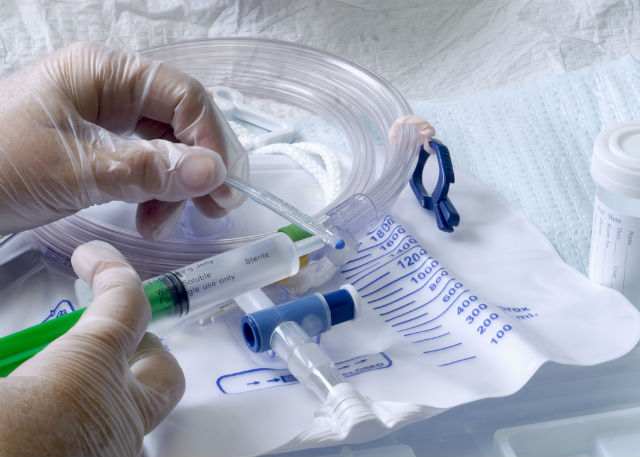As people live longer and live more actively, the demands on medical equipment have increased, too. Increasingly, innovative medical applications place further importance on the success of the materials they use. When patients’ health, mobility and comfort are involved, reliability and durability are crucial.
One material that provides durability and lightweight benefits is a polycarbonate product made by Covestro, a Germany-based global supplier of high-tech polymers. The company’s Makrolon helped make possible Breathe Technologies’ Non-Invasive Open Ventilation System (NIOV), the first wearable ventilation system for patients with breathing problems.
Makrolon, a biocompatible lightweight polycarbonate used in the palm-sized device, keeps the weight of the non-invasive mechanical ventilator under one pound. By reducing the overall size of the ventilation system, it supports patient mobility and independence.
MEDICAL PLASTICS
In the health care sector, wearable medical devices increasingly are called upon to perform a variety of important tasks, such as monitoring vital signs or delivering drugs. The tasks they perform are highly diverse, as are the demands imposed on the materials used to make them. Their popularity continues to grow as does the need for materials that satisfy the unique requirements of these devices.
U.S. life expectancy is currently about 80 years, an all-time high, along with an annual death rate that has decreased to a record low of about 70 deaths per 100,000 people,
says BCC Research analyst Mel Schlechter. It is obvious that medical technology has been the major factor in providing the means for people to lead longer and more productive lives.
“The obvious aging of the U.S. population, continuing cost-reduction pressures in the healthcare field, advances in polymer performance, introduction of new and often life-saving devices and the ever-present environmental/disposable/nondisposable medical devices,” he states.
OVERALL PLASTIC USAGE
Generally, demand for medical plastics will outpace packaging applications especially in the area of prosthetic devices and minimally invasive surgical instruments. On the other hand, plastics in the packaging sector are largely driven by cost. Most consider that the use of engineering resins will increase faster than commodity resins because of increased physical demands being placed on resins used for medical devices.
PROPERTY ADVANTAGES AND DISADVANTAGES
Polycarbonates are, in many respects, the ideal clear plastic for medical applications due to their outstanding impact resistance, good heat resistance, high strength, exceptional purity and biocompatibility, and good transparency, Schlechter says.
GENERAL GRADES
General purpose polycarbonate grades are upgraded with thermal and UV stabilizers, glass fibers, mold release agents, and ignition-resistant additives. Glass-filled polycarbonates are formulated when less mold shrinkage and higher modulus are required. Branched polycarbonates are used for applications that require high melt strength such as blow molding and structural sheet.
Polycarbonate copolymers also provide wide ranges of property improvements. Polycarbonates can be polymerized with aliphatic esters to improve flow characteristics, while aromatic ester carbonates can be used in those applications where increased heat deflection temperatures (HDTs) are needed especially for molding electronic parts.
ALLOYS/BLENDS
According to Schlechter, market opportunities for polycarbonates can be extended because they can be combined with other polymers. Blends with PBT result in tough and chemically resistant products for auto bumpers and fascias, as well as with reported medical products.
MEDICAL IMPLANT POLYMERS HAVE UNIQUE CHALLENGES
Biodegradable polymers for implantable medical devices have the unenviable task of
controlling how they function and do not break down in the sensitive environment of the
human body. Schlecter says it’s very important to understand and control the degradation and durability of these polymers. Degradation of these polymers, whether deliberate or unintentional, profoundly affects their physical performance. He cites two distinct classes of materials: bioabsorbable polymers, which are designed to degrade in a controlled manner and biodurable polymers, which are intended for long term usage.
ADVANCES IN MEDICAL DEVICE TECHNOLOGY
Bioprinting. This technology is enabling 3-D printing of replacement medical organs.
Health IT. Wireless transmission of information will continue to increase which will result in everyone with a condition being able to be monitored in
real time.
Kidney preservation technology. New systems will be able to resuscitate damaged kidneys.
Nanotechnologies. This technology will enhance and target drug delivery therapies and diagnostic capabilities.
Diagnostic breakthroughs. These will allow for better screening, earlier identification of disease presence along with implantable and wearable sensors monitoring levels and conditions.
Preservation of vision and diabetes-related diseases. This advance will progress via chip-based pixilation with RFI-based two-way communications.
CAPACITIES AND DEMAND
Worldwide demand for polycarbonate was expected to grow to almost 10 billion pounds in the next several years from the current level, which is over eight billion pounds. Usage in electrical/electronic films and sheets may become larger than optical media as polycarbonate’s largest application due to the declining use of CDs and DVDs and increasing usage of digital media.
In many cases, dates for new plant completions are delayed for a variety of reasons, and quotations for planned capacities of existent plants are often delayed or even cancelled. Generally, producers closely guard capacities, especially in very competitive engineering resins produced on a global basis.
According to Schlechter, the plastic medical device market in the U.S. should reach more than 4.6 billion pounds by 2015 and more than 5.8 billion pounds by 2020. He maintains that commodity thermoplastics dominate the market with a little more than 55% of total volume. Growth rates are fairly similar, ranging from 4.6% to 5.1% for most of the resins due to a variety of trade-offs based on property requirements, pricing, environmental and regulatory issues.
(Source: Bayer MaterialScience)




